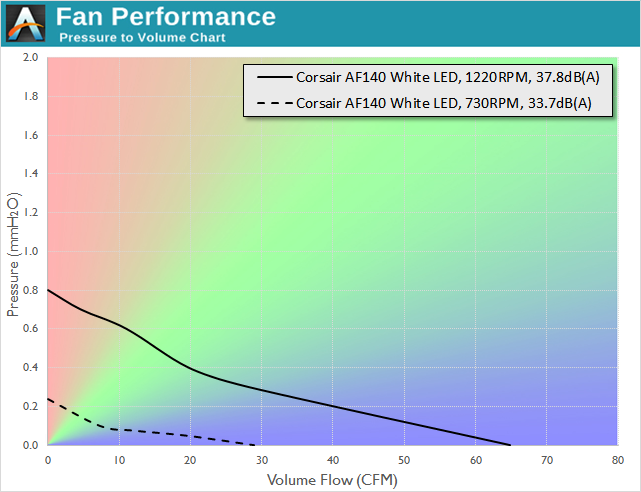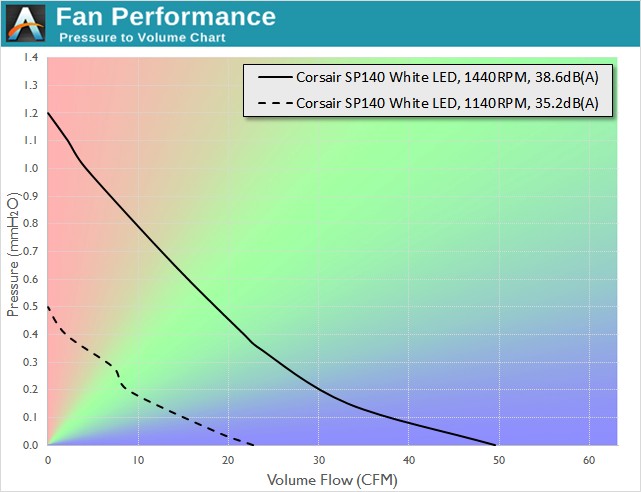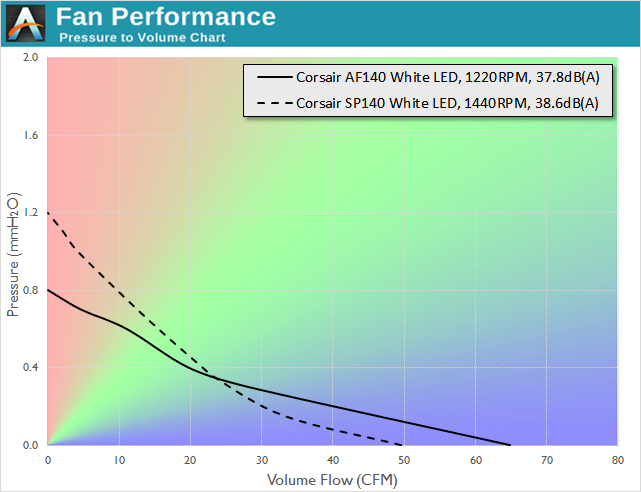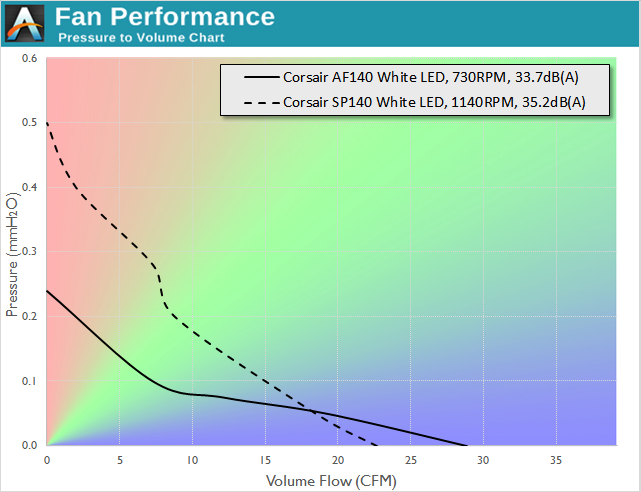The Corsair SP (Static Pressure), AF (High Airflow) 120/140mm Fan Review
by E. Fylladitakis on November 25, 2015 8:00 AM ESTCorsair's 140mm Performance
AF140 White LED Quiet Edition
As mentioned previously, the variation on Corsair's fans means that this one is our 140mm model in the 'High Airflow' (AF) category, focusing on low-impedance (case-fan style) scenarios. The LED versions are not built as sturdy as the non-LED models, and this one comes in with the 'Quiet Edition' moniker as well. Here are the results for the AF140 LED QE fan at high and low voltage settings:
As it can be seen from the above performance chart, the AF140 begins with very low static pressure readings but its airflow increases as the airflow impedance decreases. This increase is dramatic when the airflow impedance pressure drop is below 0.3 mmH2O while the fan is operating at its maximum speed.
SP140 White LED
The Static Pressure line of fans focuses more on the early end of the pressure/volume curve, aiming to get higher airflow at the same pressure while potentially sacrificing the total peak volume flow at zero pressure. Similar to the AF model above, this is a 140mm LED version but not in the quest range. Here are the 12V and 7V results:
As expected by its design and specifications, the SP140 has a good static pressure, nearly 50% better than that of the high airflow AF140. However, its pressure to flow curve declines faster and the SP140, even though it has a higher maximum speed than the AF140, cannot reach very high airflow values.
Comparing the AF140 LED QE and SP140 LED
If we do a direct comparison at the different voltage modes, we get the following for 12 volts:
Then this is for 7 volts (note the different scales on both axes):
Note that their rotational speeds are not the same at either voltage. Still, the slower AF140 can move greater volumes of air when the airflow impedance pressure drop is below 0.3 mmH2O. However, if the airflow impedance is high, the SP140 will clearly provide better performance.














92 Comments
View All Comments
DanNeely - Wednesday, November 25, 2015 - link
A suggestion for when you've got data on more fans. Since the scales on the graphs aren't constant; it would be really helpful for comparison if Bench was able to take the datapoints used to generate the performance curves and use them to create a single combined chart for the user selected set of fans/speeds.BurntMyBacon - Tuesday, December 1, 2015 - link
A max and min speed chart also needs to be in there as user selected fan speeds ignore the fact that some fans can spin quicker/slower than others are capable of spinning.Stuka87 - Wednesday, November 25, 2015 - link
My Corsair 380T came with the LED version of the fans and I was not happy with them at all. I ended up changing them out for the Enermax "Batwing" LED fans (which have removable blades for cleaning) which are much quieter but also have better airflow.supastar1568 - Wednesday, November 25, 2015 - link
Very well written write up with lots of good information.Curious, how did you go about increasing/decreasing the air resistance levels for the fans? As an mechanical engineer, I've been reading up on fan curves for work and I believe an adjustable duct type thing is common. I've always been curious to how this part is done.
Also, for anyone interested, the AMCA 210 Standard has lots of good info as well. A quick google search will bring you to the .pdf.
simonpschmitt - Wednesday, November 25, 2015 - link
Hey, nice to see a more in depth review of the matter.Just two suggestions:
First, why are you plotting pressure over volume? Iwould have done it the other way around.
Second, could you measure the impedance (ballpark figures) of some typical obstructions and post photos of them? For example finger guards, one or two tower coolers, typical filter (ideally clean and dirty, would be interessting to see the effect). Just to get a feel for the dimensions involved.
jann5s - Thursday, November 26, 2015 - link
+1EddyKilowatt - Thursday, December 3, 2015 - link
I think a necessary corollary of AT doing such a solid job of reviewing and explaining fan performance, is that they will also (have to) start measuring and publishing flow curves of the things they review that fans get hooked up to. I was mainly thinking of cases and coolers, but you are right, filters and guards qualify as well. Maybe someday that kind of data will be part of the specs that manufacturers publish.rocktober13 - Monday, November 30, 2015 - link
+1 to both suggestionsBurntMyBacon - Tuesday, December 1, 2015 - link
@simonpschmitt: "First, why are you plotting pressure over volume? Iwould have done it the other way around."Typically the controlled variable is X and the measured variable is Y. They are controlling pressure and measuring airflow so typically it would be represented as you state. That said, the data is all there and the author is technically free and correct to use R and W for variables if he chooses as long as the axis' are labeled. Though in the end, I'd just as soon have the author use the typical approach to avoid confusion.
@simonpschmitt: "Second, could you measure the impedance (ballpark figures) of some typical obstructions and post photos of them? For example finger guards, one or two tower coolers, typical filter (ideally clean and dirty, would be interessting to see the effect). Just to get a feel for the dimensions involved."
This. Very this. Also, since the author mentioned "dense radiators", measurements and photos of dense vs sparse radiators.
JanW1 - Wednesday, November 25, 2015 - link
"one Pascal is the pressure required to accelerate 1 kg of mass at a speed of 1 meters per second squared"Looks like you mixed up the definitions of a Newton and a Pascal. One Pascal is the pressure required to exert the force of one Newton per square meter. The square meter disappeared in your definition. I guess you could say "one Pascal is the pressure required to exert on a surface of one square meter the force required to accelerate 1 kg of mass at a speed of 1 meters per second squared".